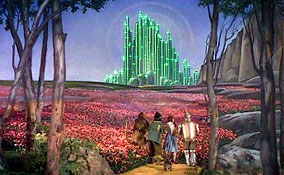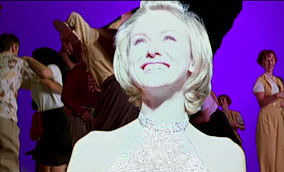TheWizardOfOzReference (by Alan Shaw)
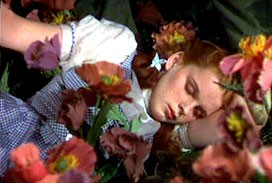 Questions about which parts of Mulholland Drive are dream sequences and which parts represent reality can be answered when you take into account Lynch's intentional homage to the Wizard of Oz format in this film. The parallels are dramatic. In Lynch's film, the opening scene reveals to us that there is a conflict. The idealized happy and loving time of the Jitterbug sequence is juxtaposed with the blurred vision and clear tension of someone who appears to be having trouble focusing and breathing as they are passing out onto a bed. Dorothy's story started similarly, with loving relationships in Kansas that are interrupted by an evil that threatened to destroy Dorothy's happiness and that seemed to extend into a storm that literally knocked Dorothy unconscious onto her bed. On the bed, in both cases, a vision begins. In Dorothy's case the vision starts off with a continuation of the terror of the storm. The tornado that Dorothy sees out of her window is no longer real, but it is clearly a representation of the real tornado that was responsible for Dorothy's injury. Out of her window, before her house lands in Oz, she even sees her antagonist transformed into a horrible and ugly witch, and the sight of her scares Dorothy so much that she throws herself down and hides her head in her bed.
Questions about which parts of Mulholland Drive are dream sequences and which parts represent reality can be answered when you take into account Lynch's intentional homage to the Wizard of Oz format in this film. The parallels are dramatic. In Lynch's film, the opening scene reveals to us that there is a conflict. The idealized happy and loving time of the Jitterbug sequence is juxtaposed with the blurred vision and clear tension of someone who appears to be having trouble focusing and breathing as they are passing out onto a bed. Dorothy's story started similarly, with loving relationships in Kansas that are interrupted by an evil that threatened to destroy Dorothy's happiness and that seemed to extend into a storm that literally knocked Dorothy unconscious onto her bed. On the bed, in both cases, a vision begins. In Dorothy's case the vision starts off with a continuation of the terror of the storm. The tornado that Dorothy sees out of her window is no longer real, but it is clearly a representation of the real tornado that was responsible for Dorothy's injury. Out of her window, before her house lands in Oz, she even sees her antagonist transformed into a horrible and ugly witch, and the sight of her scares Dorothy so much that she throws herself down and hides her head in her bed.
Similarly, as we shall examine more closely below, the first part of the vision that happens when our subject in Lynch's film passes out on the bed is also a reflection of a terrible trauma that was very real, although the resulting vision is not exactly like the trauma itself. In this opening sequence there are three parts to this trauma: one that involves an accident in a limousine; another that involves a person seeing the face of a horrible beast and then collapsing; and a third that involves a chain of calls being made through a number of phones, although the last one is not answered. All three events are especially traumatic for our subject for reasons that we shall examine later, but the parallel between these traumas and the terrible trip in the tornado that Dorothy experienced should already be clear.
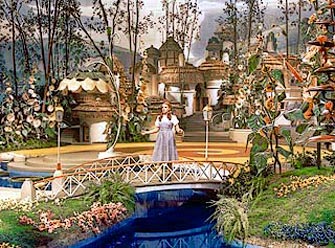 When Dorothy's house lands, she steps out into a wonderful land of beauty and promise. It is the land of Oz. The people she initially meets are sweet and supportive, and although she gets a brief scare from her antagonist again, she finds out that her antagonist is powerless to hurt her in that particular location. So all is well as she sets off down the yellow brick road. Similarly, Diane, our protagonist from Mulholland Drive, also lands in a wonderful land of beauty and promise. It is the land of LA. She flew by plane instead of in a house, but her landing is analogous to Dorothy's nonetheless. The people she meets are very friendly. And even though she gets a scare when she thinks someone has stolen her suitcases, she finds that her suitcases are safe and there is nothing to be afraid of as long as she is in this airport. So all is well, and just like Dorothy, she sets off down the road, although now it is in a yellow cab instead of on yellow bricks. Furthermore, as both Dorothy and Diane move down this road that involves something yellow, they both are driven by the memory of an aunt who they dearly loved and with whom they are trying to reconnect.
When Dorothy's house lands, she steps out into a wonderful land of beauty and promise. It is the land of Oz. The people she initially meets are sweet and supportive, and although she gets a brief scare from her antagonist again, she finds out that her antagonist is powerless to hurt her in that particular location. So all is well as she sets off down the yellow brick road. Similarly, Diane, our protagonist from Mulholland Drive, also lands in a wonderful land of beauty and promise. It is the land of LA. She flew by plane instead of in a house, but her landing is analogous to Dorothy's nonetheless. The people she meets are very friendly. And even though she gets a scare when she thinks someone has stolen her suitcases, she finds that her suitcases are safe and there is nothing to be afraid of as long as she is in this airport. So all is well, and just like Dorothy, she sets off down the road, although now it is in a yellow cab instead of on yellow bricks. Furthermore, as both Dorothy and Diane move down this road that involves something yellow, they both are driven by the memory of an aunt who they dearly loved and with whom they are trying to reconnect.
These intentional similarities with the story of Oz are there for a reason. Many reviewers note that Mulholland Drive makes use of the Oz-like device of incorporating characters from a person's real life into their fantasy world to work through issues using a surreal duality that this technique allows. But not many reviewers look much closer into other parallels with the Wizard of Oz. Yet there are other parallels that are very telling in helping us understand a larger framework that holds together Lynch's film. Just as Dorothy could only get home after she had discovered the fraudulent nature of the wizard in whom she had put her trust, so too does Diane only leave her dream after she has been to the wizard-like magician at Club Silencio who acknowledges that everything is a fraud as well. If we take this parallel further and note that the scene in Oz with the wizard also identifies the characteristics inside of Dorothy that are genuine, we can argue that the Club Silencio scene should also hold deep truths about Diane's character. As we shall see later, identifying the truth is just as important as finding out what is an illusion in Lynch's film.
Furthermore, one of the most important thematic devices in the Wizard of Oz was the way in which Dorothy's journey allowed her to personify some of her own questions about her character using the exaggerated characterizations of the Scarecrow, the Tinman and the Lion. Questions about her intelligence, her emotional priorities and her courage were on her mind as she went into her fantasy world, and her trio of strange companions helped her to resolve those questions. In Lynch's film we have a similar but darker use of this device in the characterizations of the Cowboy, Mr. Roque, and the Castigliane brothers.
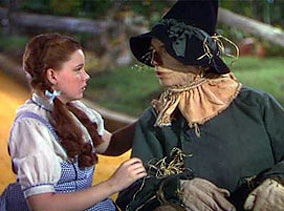 Like the Scarecrow, the Cowboy was definitely the one most interested in questions about intelligence. In his opening scene he says, "Well, just stop for a little second and think about it. Will ya do that for me?" And he follows this up by saying, "No. You're too busy being a smart aleck to be
thinkin'. Now I want ya to think and quit bein' such a smart aleck. Can ya do that for me?" It is from the mouth of the Cowboy that we get a statement that touches a core philosophic underpinning to Lynch's film, "A man's attitude goes some ways toward how a man's life will be." We shall look at this statement in greater depth at a later point, but it is clear that the Cowboy comes off as the wisest of the bunch, as did Dorothy's Scarecrow. Not only that, but in his own eerie way, he is certainly the most scary of the three as well, inspiring fear in a way that the Scarecrow could never hope to match.
Like the Scarecrow, the Cowboy was definitely the one most interested in questions about intelligence. In his opening scene he says, "Well, just stop for a little second and think about it. Will ya do that for me?" And he follows this up by saying, "No. You're too busy being a smart aleck to be
thinkin'. Now I want ya to think and quit bein' such a smart aleck. Can ya do that for me?" It is from the mouth of the Cowboy that we get a statement that touches a core philosophic underpinning to Lynch's film, "A man's attitude goes some ways toward how a man's life will be." We shall look at this statement in greater depth at a later point, but it is clear that the Cowboy comes off as the wisest of the bunch, as did Dorothy's Scarecrow. Not only that, but in his own eerie way, he is certainly the most scary of the three as well, inspiring fear in a way that the Scarecrow could never hope to match.
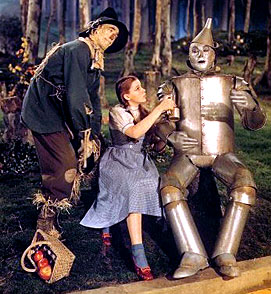 Mr. Roque, on the other hand, is like the Tinman. He has a difficult time moving, physically and otherwise. Sitting in a wheelchair with a paralyzed body, Mr. Roque presents us with the quintessential example of what it means to be frozen and unyielding. He is exactly like the Tinman when Dorothy first meets him. Rusted and rigid, he is capable of only a few words at a time. This physical state has a moral equivalent which we see in Mr. Roque when he would rather "shut everything down" then allow himself to be flexible. This character trait is extremely dangerous and can even be suicidal in certain circumstances of life, which is a point on which Lynch elaborates throughout his film.
Mr. Roque, on the other hand, is like the Tinman. He has a difficult time moving, physically and otherwise. Sitting in a wheelchair with a paralyzed body, Mr. Roque presents us with the quintessential example of what it means to be frozen and unyielding. He is exactly like the Tinman when Dorothy first meets him. Rusted and rigid, he is capable of only a few words at a time. This physical state has a moral equivalent which we see in Mr. Roque when he would rather "shut everything down" then allow himself to be flexible. This character trait is extremely dangerous and can even be suicidal in certain circumstances of life, which is a point on which Lynch elaborates throughout his film.
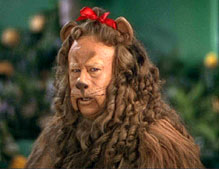 And finally the Castigliane brothers are a more somber version of the Lion, with their focus on intimidation and bravado. In their opening scene they enter a conference room with moody attitude and one of them, Vincenzo, quickly gets into a staring down contest with Adam, another central character in the movie. Ultimately, Adam loses this contest when he must divert is eyes. Meanwhile, Luigi, the other brother has the others in the room terrified over whether or not he will approve of the espresso that they have brought to him. Needless to say, he does not and they try to put a good face on the fact that they must cower and grovel in response. Vincenzo then literally roars in front of them all saying something like, "Stop It!" After which, this mean
ol' lion sends Adam packing. And what's Luigi doing during Vincenzo's outburst? He's focusing his attention on getting some lint off of his jacket. In other words, he's grooming himself just like any good feline would be doing at that moment.
And finally the Castigliane brothers are a more somber version of the Lion, with their focus on intimidation and bravado. In their opening scene they enter a conference room with moody attitude and one of them, Vincenzo, quickly gets into a staring down contest with Adam, another central character in the movie. Ultimately, Adam loses this contest when he must divert is eyes. Meanwhile, Luigi, the other brother has the others in the room terrified over whether or not he will approve of the espresso that they have brought to him. Needless to say, he does not and they try to put a good face on the fact that they must cower and grovel in response. Vincenzo then literally roars in front of them all saying something like, "Stop It!" After which, this mean
ol' lion sends Adam packing. And what's Luigi doing during Vincenzo's outburst? He's focusing his attention on getting some lint off of his jacket. In other words, he's grooming himself just like any good feline would be doing at that moment.
These three characters have been conceived as ominous versions of Dorothy's lighthearted companions, and as we shall see, they are there to help Diane resolve a dark struggle raging inside of her. The fact that Lynch is able to appropriate benign cinematic characterizations from Oz for his more foreboding purposes in Mulholland Drive, is quite an accomplishment.
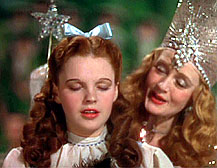 Another, more obvious appropriation that Lynch has made from the Wizard of Oz, is the name Winkie's. In Oz, the Winkies were the people who lived in the west and were ruled over by the Wicked Witch of the West. In Mulholland Drive,
Winkie's is the name of the diner where a wicked creature from behind the diner exerts some terrible power. This wicked creature is in LA, and that makes it from the west, just like the Wicked Witch of the West. And there is even a parallel for
Glinda, the Good Witch of the North. It is Aunt Ruth, who has red hair like
Glinda, and who left on a trip to the north. Like Glinda, Aunt Ruth has given Diane help in her journey through the Oz-like land of her dreams, which in Diane's case is Hollywood. But unlike
Glinda, Aunt Ruth dies before Diane gets there, and this turns out to be tragic, because it means that Diane's story cannot end like Dorothy's.
Another, more obvious appropriation that Lynch has made from the Wizard of Oz, is the name Winkie's. In Oz, the Winkies were the people who lived in the west and were ruled over by the Wicked Witch of the West. In Mulholland Drive,
Winkie's is the name of the diner where a wicked creature from behind the diner exerts some terrible power. This wicked creature is in LA, and that makes it from the west, just like the Wicked Witch of the West. And there is even a parallel for
Glinda, the Good Witch of the North. It is Aunt Ruth, who has red hair like
Glinda, and who left on a trip to the north. Like Glinda, Aunt Ruth has given Diane help in her journey through the Oz-like land of her dreams, which in Diane's case is Hollywood. But unlike
Glinda, Aunt Ruth dies before Diane gets there, and this turns out to be tragic, because it means that Diane's story cannot end like Dorothy's.
Since we have parallels in Mulholland Drive for Dorothy, the Scarecrow, the Tinman, the Lion, the Good Witch of the North, Auntie Em, the Wizard, and the Wicked Witch of the West, you might suspect that we should be able to find the Wicked Witch of the East as well. And it is pretty obvious who fits that bill when you consider that Dorothy’s fantasy essentially begins with the death of the Wicked Witch of the East, and Diane’s fantasy begins essentially after Camilla’s death. In fact, in the Wizard of Oz the Wicked Witch of the East had been an oppressive force in the land of the Munchkins until Dorothy accidentally killed her. Similarly, Diane has Camilla killed in part because of the oppressive nature of Camilla’s relationship with her, and that death is ultimately expressed through an accident in the beginning of the fantasy. The Rita persona survives what is both an assassination attempt and an accident, but her Camilla identity is stripped away and in a sense killed off during the accident. Camilla dominated Diane because Diane was obsessed with her, and it is only after Camilla’s death that the old innocence of Diane’s Betty persona is allowed back into Diane’s fantasy world. With the Betty persona’s relationship to the Rita persona, Diane is trying to hold onto the glamour of Camilla without associating it with the malevolent identity of the real Camilla, because the glamour is connected to Diane’s long lost innocent dream to become a movie star. However, unlike Dorothy’s journey to regain her lost sense of hope in her struggle to find the right direction for her life through her dream, Diane’s quest in her fantasy ultimately fails.
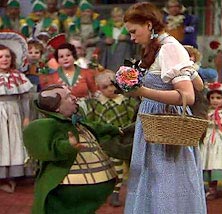 On a less consequential note, I believe that Lynch has also been successful at including a more subtle tribute to other well known characters of Oz. In my view, his inclusion of a little person, Michael J. Anderson, in the prosthetic body of Mr. Roque is a nod to the inhabitants of
Munchkinland. Because of how comprehensive they are, Lynch's many tributes to Wizard of Oz provide for us certain structural elements and thematic content that we can use to unlock some of the mystery to the meaning of Mulholland Drive.
On a less consequential note, I believe that Lynch has also been successful at including a more subtle tribute to other well known characters of Oz. In my view, his inclusion of a little person, Michael J. Anderson, in the prosthetic body of Mr. Roque is a nod to the inhabitants of
Munchkinland. Because of how comprehensive they are, Lynch's many tributes to Wizard of Oz provide for us certain structural elements and thematic content that we can use to unlock some of the mystery to the meaning of Mulholland Drive.
By understanding where the structure of Lynch's movie parallels that of the Wizard of Oz, we can be sure of where the beginning and ending of Diane's fantasy life occurs. Furthermore, if we compare Diane to Dorothy, we can intuit that the major characters in Diane's fantasy life are struggling through issues with which Diane herself is struggling. And we can assume that each and every scene in the fantasy portion of the film will have characters in them who represent some aspect of Diane's psyche, or some context concerning the crisis in her life that she is facing. Even the Cowboy, Mr. Roque, and the Castigliane brothers represent certain questions about character running through Diane's inner trials. This is an important point to note because most reviewers see the fantasy portions of this movie as chiefly reflecting the struggles Diane is having with others. While this is the surface truth to some degree, I believe that when you dig deep enough you find that the most significant issues she is trying to address are those that involve her struggle to come to terms with herself.
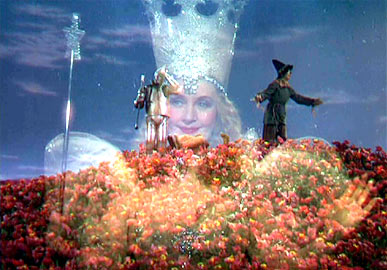 Inside of the cast of characters within Diane's fantasy, most of the main characters are aspects of Diane's personality. This is not to say that she has a multiple personality disorder, but it is to say that she is struggling with discord within her heart and mind and is in need of some type of resolution. And some of this discord can be traced to her troubled past, while other aspects of it can be blamed on the difficult the inner conflict associated with the hubris that is often involved and perhaps required to some degree when pursuing the Hollywood dream of stardom. I
also see them as connected to the conceit fostered by the Hollywood enterprise with which Diane is struggling. In this context we can say that the Cowboy, Mr. Roque and the Castigliane brothers represent Diane's pride, stubbornness, and arrogance. Yet because of Diane's poor self-image and because of her obsession with Camilla, these three characterizations have become twisted and they are no longer promoting Diane's career, as they probably originally were when Diane first arrived in Hollywood before she met Camilla.
Inside of the cast of characters within Diane's fantasy, most of the main characters are aspects of Diane's personality. This is not to say that she has a multiple personality disorder, but it is to say that she is struggling with discord within her heart and mind and is in need of some type of resolution. And some of this discord can be traced to her troubled past, while other aspects of it can be blamed on the difficult the inner conflict associated with the hubris that is often involved and perhaps required to some degree when pursuing the Hollywood dream of stardom. I
also see them as connected to the conceit fostered by the Hollywood enterprise with which Diane is struggling. In this context we can say that the Cowboy, Mr. Roque and the Castigliane brothers represent Diane's pride, stubbornness, and arrogance. Yet because of Diane's poor self-image and because of her obsession with Camilla, these three characterizations have become twisted and they are no longer promoting Diane's career, as they probably originally were when Diane first arrived in Hollywood before she met Camilla.
The Jitterbug connection
The Jitterbug scene is a great beginning point to discuss how Diane perceived her reality. It may seem absurd to think that becoming a movie star is a natural next step after winning a Jitterbug contest, but that Diane wanted to believe this is what makes it so important. Dorothy, in the Wizard of Oz, had a similar mindset when she had to battle an evil woman bent on killing her beloved dog. To save the life of her dog, Dorothy runs away ostensibly in search of that magical place she sang about called, "Somewhere Over the Rainbow." The lyrics to the song seem no more and no less absurd than Diane's connection between the Jitterbug contest and her Hollywood ambitions, but what makes both of these romantic notions so moving is how heartfelt and compelling they were to these sweet young women. Moreover, if we view these young women as being on an epic quest to protect something dear and precious in their hearts, then the lyrics to Dorothy's song effectively sums up both of their mindsets in poetic fashion:
|
Somewhere over the rainbow Somewhere over the rainbow Someday I'll wish upon a star Somewhere over the rainbow If happy little bluebirds fly |
|
|
|
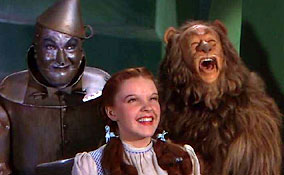
|
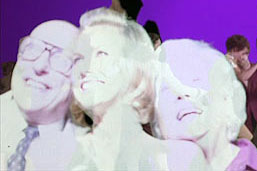
|
"If happy little bluebirds fly ... Why, oh why can't I?" Happiness and the ability to soar are what both Diane and Dorothy wanted, and in their naïve view they thought this could only be possible if they escaped their present reality to go far away to a land of their dreams. We don't know the lullaby from which Dorothy's dreamland took shape, but we do know that Diane's dream was based on her conceptions of her aunt's successful life in Hollywood, and it was triggered by the thrill of her being in the spotlight, probably for the first time. Diane's success in the Jitterbug contest gave her a sense of being valuable in a way that she was not used to feeling. And I believe that she was desperately trying not to go back to her old reality.
While running away, Dorothy tells Professor Marvel, "Nobody cares about me at home. They wouldn't even miss me." And she is adamant about this opinion, as is evident when the Professor expresses his doubts by saying, "Aw, come, come, come." But Dorothy reiterates, "No, they won't - honestly." The fact that her family had allowed her dog to be condemned to death caused Dorothy to lose all hope in them. And I believe that Lynch has developed Diane's character along the same lines, although in Diane's case her angst involving the situation with her family is much darker and more insoluble. This is true even though Diane tries to see the grandparents who raised her in the best light possible, with blurry and unstable images of them embracing her at the Jitterbug contest, and smiley and encouraging faces seeing her off at the airport after arriving in her fantasy land. But the evidence is still there that Diane felt abused and unloved. And the possibility exists that her grandparents may have only embraced her when she was in the spotlight or when she was on the road to Hollywood, implying in a way that they only viewed her as important in that context. This would be yet another slight, devaluing the intrinsic importance of Diane as her potential stardom becomes the focus. If this is the case, then she was simply trading one type of abuse for another, which would not improve her self-image. It is not a bad thing to want to become a star, but it is another thing altogether when you need to become one to feel good about yourself.
Related: Overview "The Wizard Of Oz" references in Mulholland Dr.
